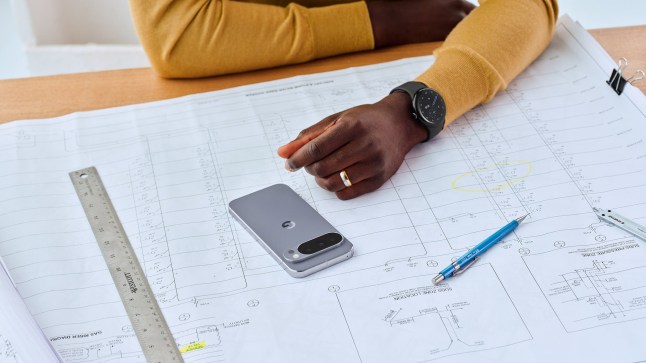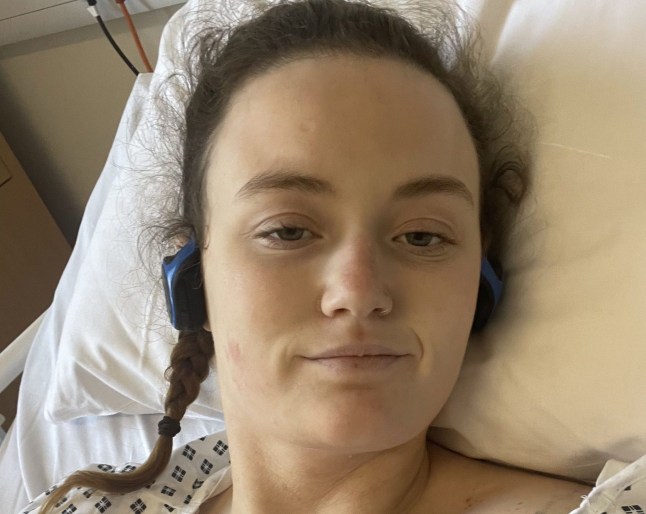22 Oct, 2025 | Admin | No Comments
Exclusive: Claudia Winkleman's Traitors stylist on 'Highland goth' wardrobe inspired by 'cool' Princess Anne

Stylist Sinead McKeefry, who’s worked with Claudia for 20 years, reveals her Traitors styling secrets, which royal’s fashion is seriously underrated – and which celebrities she thinks are best-dressed
22 Oct, 2025 | Admin | No Comments
Running a business? Enjoy a free personal assistant and gift worth up to £350 when you buy a Google Pixel with Vodafone Business

Metro journalists select and curate the products that feature on our site. If you make a purchase via links on this page we will earn commission – learn more
Whether you’re managing a large business or operating a small start-up, a good phone can be essential for staying on top of the day to day tasks.
Whether that’s managing projects on the go, taking client calls from wherever you’re working, or capturing content that you can easily transform into something special.
That’s where the Google Pixel range comes in. With built-in AI support, it helps you stay organised with smart tools to book meetings, arrange travel, or even take minutes in real time.
And right now, Vodafone Business is making the deal even sweeter. When you pick up a Google Pixel device, you can be treated to a free gift worth up to £350. Yes, really.
Treat your business to a Google Pixel 10 Pro, which was only released this summer and guarantees smooth visuals, as well as an all-day battery life.
You can also enjoy high-res videos and pictures with the advanced camera system, and the fast 5G connectivity means it’s ideal for working in and out of the office. If you buy one before October 29th, you’ll also get a free pair of Pixel Buds Pro 2, which typically retail at £219.
These buds offer active noise cancellation for an immersive sound experience, as well as the ability to drown out background sounds. Perfect for when you need to work in a busy environment. A full charge gives you 30 hours of listening, and they’re sweat and water-resistant if you want to use them for a gym session.
If you go for the Google Pixel Pro before November 5th, you’ll still be treated to high performance but on a bit of a budget. For a limited time, Vodafone Business will give you a free pair of Pixel Buds A-Series, which retail at £109.99.
The Google Pixel 9a was released in April this year and boasts a 6.3-inch OLED display, which is a large screen the size of a tablet, as well as a 120Hz refresh rate, which means the screen updates 120 times every second, making everything look super smooth.
If you splurge on this model before October 29th, Vodafone Business will treat you to an Asus Chromebook Flip C214, which retails at almost £350.
This compact laptop measures 11.6 inches and flips over into a tablet, making it great for professional and personal use. It’s also built to military‑grade standards with rubber bumpers, so this bad boy can take a few bumps, and it’s spill-resistant, which is great news if you’re prone to knocking your coffee over.
Amazing tech that makes your day easier, and a free gift? We’re gonna call Vodafone Business Santa, because they’re spoiling us with presents.
Follow Metro across our social channels, on Facebook, Twitter and Instagram
Share your views in the comments below
22 Oct, 2025 | Admin | No Comments
Lady Eliza Spencer surprises with 'natural' hair transformation – rare photos

Princess Diana’s niece, Lady Eliza Spencer, underwent a mermaid hair transformation and looked incredible on 20 October when she attended the Estee Lauder Companies’ Breast Cancer Campaign Pink Ribbon Dinner at NIJU in London alongside her twin sister Lady Amelia Spencer, as well as The Inheritance star Elizabeth Hurley.
22 Oct, 2025 | Admin | No Comments
Why scientists are finally investigating the menopause symptom that derails careers


As the majority of women admit to suffering brain fog during menopause, isn’t it high time we finally closed in on a solution to this silent saboteur of success?
It will come as no surprise to women navigating the menopause to learn that a new study has revealed that 86% report brain fog as a key symptom.
The study, launched this week by campaign group Menopause Mandate, revealed that brain fog is not only the most commonly reported, but also the most disruptive symptom, for the second year in a row.
The survey is the newest piece of research on the deep and lasting impact menopause is having on women.
Mariella Frostrup, chair of Menopause Mandate, said that over 15,000 women had taken part in the survey and the results offer a sobering picture of menopause in our society today.

The survey data is now being analysed by an expert team at University College London led by Aimee Spector, Professor of Clinical Psychology of Ageing and Director of the UCL Mind Lab.
The hope is that the findings will contribute to vital research that will inform healthcare policy and provide solutions for the most challenging symptoms — especially brain fog, which continues to be a silent workplace saboteur for millions of women.
The survey revealed that 16% of women changed or quit their job as a direct result of the symptom.
Brain fog can manifest in many ways: difficulty concentrating, forgetting words and events, and struggling to complete tasks. Such mental cloudiness can be exhausting and concerning, with many women fearing it may signify more sinister conditions such as dementia.

‘There is no formal ‘diagnosis’ for brain fog and no evidence-based or recommended treatment options, pointing to an enormous clinical gap,’ says Professor Spector. ‘This is the focus of much of my research at UCL.’
She continued: ‘It manifests individually. I can offer some hope to women in that it appears to resolve after menopause as the brain ‘resets’.
‘However, it is very distressing, and we urgently need to recognise and support it.
‘The volume and breadth of this survey offers a valuable insight into menopause in the UK. Our analysis of the data from the survey will hopefully be another piece in the jigsaw’.
She adds that this is a research field that barely existed a few years ago.
‘We have the odd clinical study from 20 years ago showing that approximately ten per cent of women in perimenopause have clinically significant drops in cognitive tests.
And it’s not only careers that suffer. In fact, 96% of women report that their quality of life was affected by menopause.
Further results revealed the impact of menopause on work and the lifestyle changes that women are making.

Elsewhere at the launch of the study, TV presenter and women’s health advocate Cherry Healey led a panel on lifestyle and advice.
Here, six out of ten women said that they are doing more exercise to ease symptoms, with most walking and just under half lifting weights.
‘When asked which lifestyle changes were the most beneficial, exercise ranked top,’ said Healey. ‘This is great news. A holistic approach to menopause is a subject very close to my heart. We all need to support ourselves.’
A panel led by broadcaster and campaigner Carol Vorderman exposed the reality of menopause and the workplace, with 77% saying that menopause symptoms were impacting their work.
There remain concerning gaps in menopause education. Only 14% of women are finding out about menopause from a healthcare professional compared to 40% from social media.

‘These findings show menopause is not just a women’s health issue — it’s an economic one,’ says Frostrup. ‘Anxiety, brain fog and low mood are driving talented women out of the workplace, often years before they were ready to leave.
‘We urgently need menopause to be recognised as part of the NHS 40+ health check so women can understand the signs earlier, and create workplaces that are better prepared to support them.’
It’s hoped that the findings will speed up research for a solution to the most prevalent symptoms, along with institutional support for women experiencing them.
22 Oct, 2025 | Admin | No Comments
I was diagnosed with deadly sepsis after experiencing one lesser-known symptom


In September 2024, thrill-seeker Skye Owen, was living an active lifestyle in Cornwall.
The 23-year-old loved to hike, surf, snowboard and explore on her motorbike.
So, when she began experiencing back and hip pain following a busy weekend, she wasn’t particularly worried.
But Skye’s joint pain was actually experiencing a lesser-known symptom of sepsis, a deadly condition which occurs when the body reacts to an infection.
Her condition was so critical, that doctors have since said she didn’t realise how ‘close’ she was to death.

Speaking of her experience, Skye says: ‘The pain was indescribable. It was that hopeless feeling of ‘there is nothing I can do,’ she said.
When Skye first started experiencing symptoms last year, she assumed it was a sporting injury.
‘I thought I must have done something surfing or fallen weirdly, which wasn’t out of the ordinary,’ she explained.
‘The pain was a mix of a constant dull ache and every time I took a step it was a sharp shooting pain going down my leg.’

After visiting the GP, she was told her symptoms were most likely due to sciatica.
However, just hours later, the pain was becoming unbearable, and Skye’s parents called 111, but she was again told it was the common ailment.
By the following morning Skye’s pain had increased even further: ‘The pain was not just when I moved anyway, it was constant and pulsating down my left leg and up my back.’
She was in so much pain, she says she ‘thought it would be easier to just die.’
Desperate, her parents eventually called 999, and she was rushed to hospital – but doctors still weren’t convinced she was seriously unwell.

‘At the end of the first day, the doctor came in and said it was time to leave as the scans were fine,’ she says.
‘It’s terrifying to think that I could have gone home. They said I couldn’t be there for back pain and I was being dramatic,’ Skye recalled.
Refusing to leave, Skye wasadmitted onto a ward for pain management. It was there that she developed a fever – a more common symptom of sepsis – and a subsequent MRI scan revealed septic arthritis in her pelvis and hip (a localised joint infection), which developed into full-body sepsis, which has a mortality rate of 20%.

Skye noted: ‘I was on the first ward for about four or five days before they started to realise it was sepsis.
‘My mum and dad pushed for another scan and they then did a much more in-depth MRI on my hip and pelvis. This is when they realised the sepsis was also in my joints, which is why I was in so much pain.’
What is sepsis?
- According to the World Health Organisation (WHO) sepsis is a life-threatening condition that happens when the body’s immune system has an extreme response to an infection, causing organ dysfunction.
- While sepsis tends to be higher risk for older individuals or people with pre-existing health conditions, it can affect anyone – at any age.
- Sepsis is usually caused by bacterial infections. However, it can also be the result of other infections such as viruses, parasites or fungi.

Upon being diagnosed, medics sprung into action. Skye underwent surgery and had the infection scooped out of her hip. She was then put on antibiotics.
After a month in hospital, Skye was discharged and has been staying with her parents while she relearns how to walk again. During her hip surgery a nerve injury left Skye with zero sensation in her leg.
However, regular physiotherapy has already helped her regain some strength.
Over a year after she first started experiencing pain, Skye isn’t yet totally in the clear. She has regular blood tests and MRIs and also still has no further insight into how she contracted sepsis in the first place.

But now, she’s focused on ensuring no-one else suffers a similar situation, urging others to ‘trust their gut’ as there’s every chance it could be a ‘life or death’ situation.
A spokesman for NHS Cornwall and Isles of Scilly Integrated Care System said: ‘Across the NHS we are committed to learning from people’s experiences to improve care and safety, have reviewed and evaluated sepsis practice in the Cornwall and Isles of Scilly health system and are implementing recommendations in line with best sepsis practice, to improve awareness and early diagnosis.
‘Additionally two new initiatives are in place to support patients and families, Jess’s Rule for GP surgeries and Martha’s Rule in hospitals, which can be used to request an urgent patient review, ensuring early action, particularly for time-critical conditions like sepsis.’

Jess’ rule was created in honour of Jessica Brady, who passed away of cancer at the age of 27. In the five months lead up to her death Jessica had 20 GP consultations – none of which resulted in a cancer diagnosis.
Martha Mills, was aged just 13 when died after developing sepsis in hospital, where she had been admitted with a pancreatic injury after falling off her bike.
Martha’s family felt as though they were not listened to by medical professionals when they tried to report their fears about her deteriorating condition.
‘I knew there was something wrong as I know myself and I know my pain tolerance. You know your body better than anyone else,’ says Skye.
Common symptoms of Sepsis
The most common symptoms of Sepsis can be identified by the following acronym:
- Slurred speech or confusion
- Extreme shivering of muscle pain
- Passing no urine (in a day)
- Severe breathlessness
- It feels like you’re going to do
- Skin mottled or discoloured
Muscle or join pain is definitely one of the lesser known symptoms, however, it can definitely still be a sign of Sepsis.
Do you have a story to share?
Get in touch by emailing MetroLifestyleTeam@Metro.co.uk.
22 Oct, 2025 | Admin | No Comments
Princess Anne brushes off controversy in cropped jacket that hasn't left her wardrobe in 3 years

Princess Anne brushed off the controversy surrounding her brother, Prince Andrew, who relinquished his titles last week after being repeatedly linked to convicted sex offender, Jeffrey Epstein, in a cropped jacket that hasn’t left her wardrobe in three years while visiting Scotland Yard.
22 Oct, 2025 | Admin | No Comments
Cat Deeley's £30 M&S mini skirt is a masterclass in wearing one, whatever your age

Cat Deeley’s green Marks & Spencer skirt is the thing your autumn/winter wardrobe has been missing. Shop it for £30, plus Cat’s fair isle jumper from Barbour.
22 Oct, 2025 | Admin | No Comments
Bronzed Princess Kate was 'quietly powerful' in Greek goddess gown

The Princess of Wales was ‘quietly powerful’ in a Greek goddess gown as she attended an event in support of the In Kind Direct charity at Clarence House in 2011.
22 Oct, 2025 | Admin | No Comments
Meghan Markle's 4-inch heels for New York baby shower were her secret style weapons

The Duchess of Sussex’s New York baby shower skinny jeans and 4-inch heels earned her style icon status as she stepped out with her close friend and fellow Suits star Abigail Spencer in 2019 – see unearthed photos.
22 Oct, 2025 | Admin | No Comments
LOOKFANTASTIC’s £705 Beauty Vault is back – and it’s a total steal at just £150

Metro journalists select and curate the products that feature on our site. If you make a purchase via links on this page we will earn commission – learn more
We’ve officially found the beauty bargain of the month, and packed full of almost £1000 of best-selling beauty must-haves, we predict it’s going to sell out fast.
Whether you’re gifting someone else or yourself, the new LOOKFANTASTIC Beauty Vault is a huge beauty treat set to win you some serious brownie points.
Worth over a whopping £705 but yours for just £150 (a huge saving of £555), this year’s Beauty Vault is the brand’s most luxurious curation yet, filled with skin, hair and makeup must-haves loved by the masses – but, back by popular demand, it’s not likely to stick around for long.
Bigger and better than beauty boxes gone by, this top-rated vault features 15 full-size icons from some of the world’s most coveted brands, from Sol de Janeiro and Fenty Beauty to Color Wow, Medik8 and Anastasia Beverly Hills.
In fact, everything in the coveted vault is a full-sized product, making stocking up on iconic brands incredibly affordable.
Take, for example, the Rodial Bee Venom Eye Cream. This viral Rodial product is worth an astonishing £145 (£5 shy of the cost of the vault itself), a total bargain if you’d been looking to snap it up anyway.
Gentle enough to use on the delicate skin around the eye area, this cream works to rejuvenate your skin’s elasticity, as well as smooth the appearance of fine lines and wrinkles.
Another impressive product in the vault is the Medik8 Daily Radiance Vitamin C 50ml, a top-seller from the brand.
Worth £59, this two-in-one moisturiser combines a potent vitamin C concentrate with SPF 30 to shield against the sun’s rays while preventing and smoothing the appearance of fine lines.
What's in the LOOKFANTASTIC Beauty Vault?
- Rodial Bee Venom Eye 25ml (Full Size) Worth £145
- Zelens Power D Fortifying and Restoring Serum 30ml (Full Size) Worth £125
- GRANDE Cosmetics GrandeLASH-MD Lash Enhancing Serum 2ml (Full Size) Worth £62
- Anastasia Beverly Hills Brow Genius Brow Serum 1pc (Full Size) Worth £61
- Aromatherapy Associates Revive Morning Body and Massage Oil 100ml (Full Size) Worth £60
- Medik8 Daily Radiance Vitamin C 50ml (Full Size) Worth £59
- StylPro Mini Microcurrent Device 1pc (Full Size) Worth Over £29
- MAKE UP FOR EVER Mist and Fix-23 Spray 100ml (Full Size) Worth Over £28
- MZ Skin Vitamin-Infused Facial Treatment Mask 1pc (Full Size) Worth £25
- Color Wow Xtra Large Bombshell Volumizer 195ml (Full Size) Worth £24
- Sol de Janeiro Brazilian 4 Play Moisturizing Shower Cream-Gel 385ml (Full Size) Worth £23
- Fenty Beauty Gloss Bomb Stix – Two’Lip Kiss 1pc (Full Size) Worth £23
- Ritual of Ayurveda Sweet Almond & Indian Rose Body Scrub 300g (Full Size) Worth Over £18
- Morphe 9T Neutral Territory Palette (Full Size) Worth £14
- BLEACH LONDON Reincarnation Mask 200ml (Full Size) Worth £10
Alongside makeup must-haves, more skin essentials and even an impressive microcurrent device, this beauty edit truly has everything you could need to treat yourself or someone special.
Whether you’re looking to stock up on your most-loved formulas or try out some viral hits before committing to them full price, the LOOKFANTASTIC Beauty Vault is an edit you’re going to want to get your hands on now while it’s still in stock.
Follow Metro across our social channels, on Facebook, Twitter and Instagram
Share your views in the comments below




